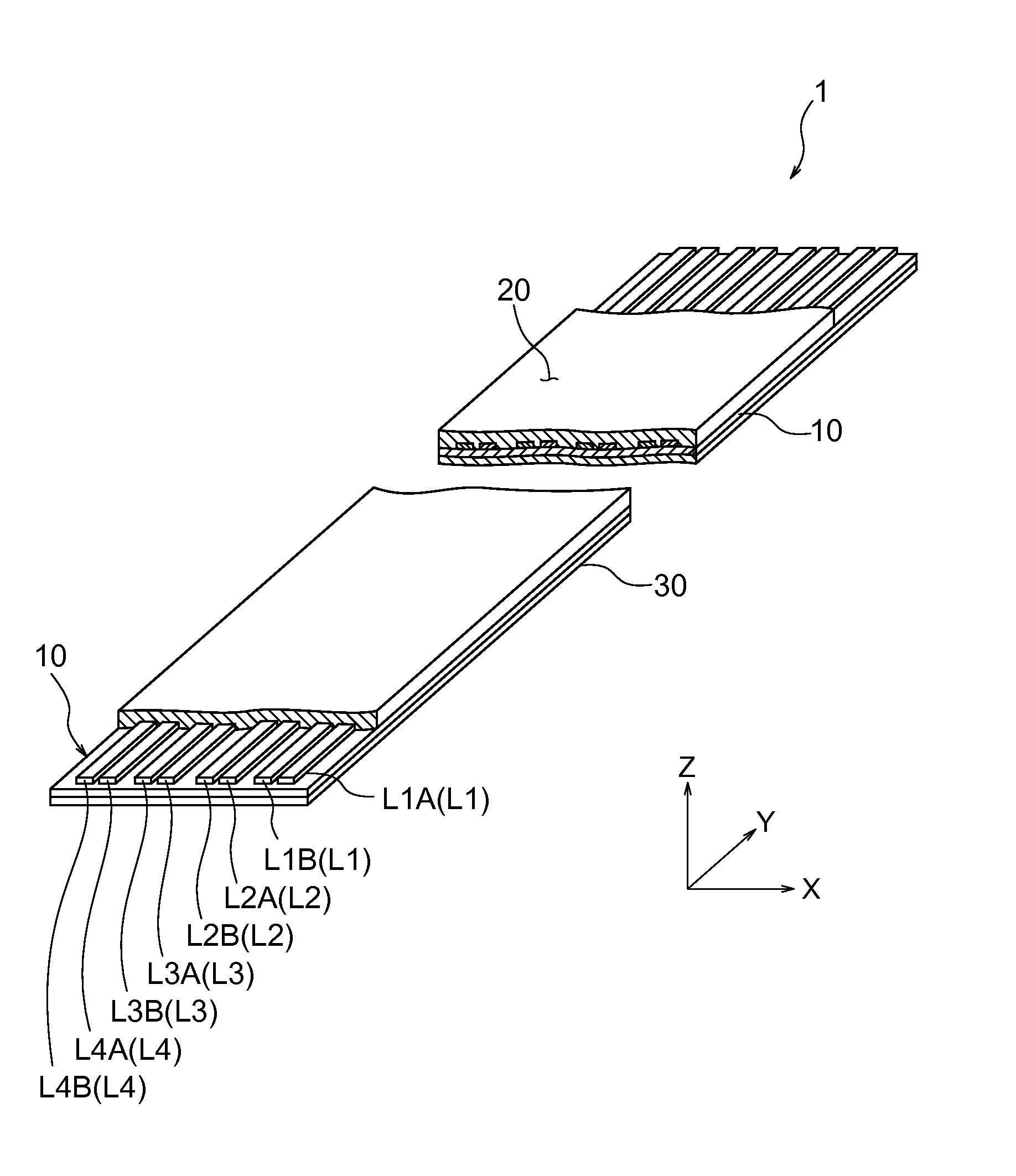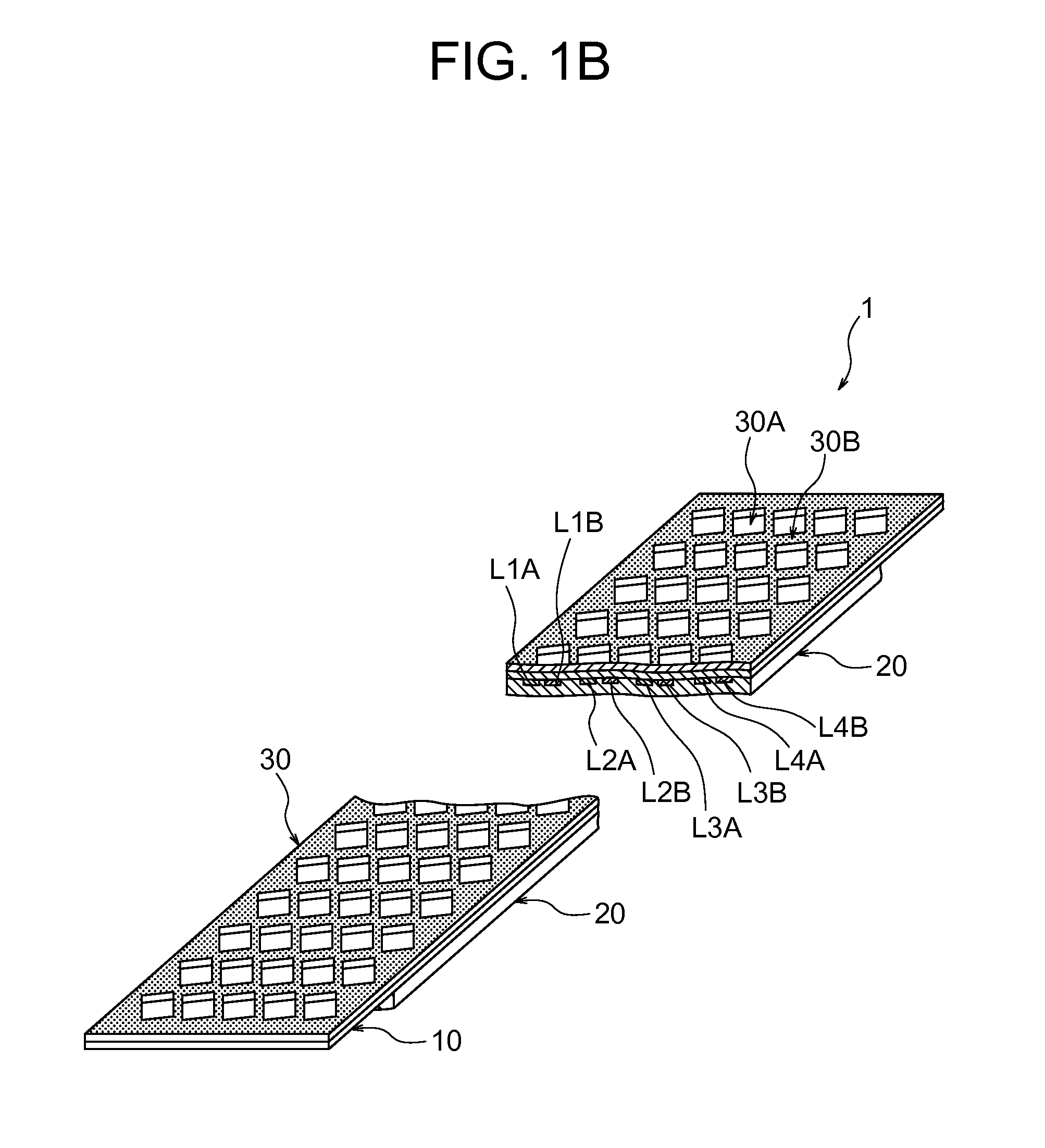Printed wiring board
a wiring board and printed technology, applied in the direction of waveguides, waveguide type devices, high frequency circuit adaptations, etc., can solve the problems of deteriorating transmission quality, affecting the transmission quality, and the difference in transmission speed between signals that cannot be suppressed at the curved portions of signal lines, so as to achieve high transmission quality and long length
- Summary
- Abstract
- Description
- Claims
- Application Information
AI Technical Summary
Benefits of technology
Problems solved by technology
Method used
Image
Examples
first embodiment
[0036]A first embodiment of the present invention will hereinafter be described with reference to the drawings. In the present embodiment, examples will be described in which a printed wiring board 1 according to the present invention may be applied to transmission lines that connect between circuits in a device, between a circuit and a device, or between devices. The printed wiring board 1 according to the present invention is suitable for transmission of high speed signals and performs differential signaling based on various standards, such as LVDS, MIPI, HDMI (registered trademark) and USB. The printed wiring board according to the present embodiment is provided with differential signal lines, which comprise at least one pair of signal lines and transmit signals in accordance with various standards to execute differential signaling. The form of the differential signal lines is not particularly limited, and a known form at the time of filing of the present application may be used ...
working example 1
[0067]A working example of a wiring board according to the present embodiment will hereinafter be described.
[0068]A copper-clad laminate was prepared such that each main surface of a polyimide substrate of a thickness of 25 mm was laminated with copper foil of a thickness of 18 μm via an adhesive of a thickness of 10 μm. Holes for through-holes were opened in the copper-clad laminate using a drill of 0.15 mm. The through-holes were formed to connect ground pads GPs (see FIG. 11A) with a lower surface ground layer (see FIG. 11A, for example). Copper plating of 15 μm was formed on the copper foil surfaces and in the through-holes. Subsequently, etching was performed using photolithography method to form signal lines L100 at the side of one main surface of the copper-clad laminate and a ground layer 30 of a mesh structure on the other main surface. Furthermore, the copper foil-exposed part was attached, in an opened state, to a cover film comprising a polyimide substrate of a thickness...
second embodiment
[0079]With reference to FIG. 7A to FIG. 10, the second embodiment will hereinafter be described. The second embodiment has a different feature that the mesh structure of the ground layer 30 is configured of a longitudinal grid pattern. Basic features and actions of the second embodiment are common with those of the first embodiment. Here, to avoid repetition in descriptions, descriptions for the common features are borrowed from those for the first embodiment.
[0080]FIG. 7A is a plan view, viewed from the side of one main surface, of an insulating substrate 10 formed with model signal lines L20 to L26 in the second embodiment. FIG. 7B is a plan view, viewed from the side of the other main surface, of the insulating substrate 10 formed with a ground layer 30 of a longitudinal grid pattern. FIG. 7C is a plan view of the insulating substrate 10 viewed from the side of the one main surface like in FIG. 7A, but with the ground layer 30 on the other main surface being transparently viewed....
PUM
 Login to View More
Login to View More Abstract
Description
Claims
Application Information
 Login to View More
Login to View More - R&D
- Intellectual Property
- Life Sciences
- Materials
- Tech Scout
- Unparalleled Data Quality
- Higher Quality Content
- 60% Fewer Hallucinations
Browse by: Latest US Patents, China's latest patents, Technical Efficacy Thesaurus, Application Domain, Technology Topic, Popular Technical Reports.
© 2025 PatSnap. All rights reserved.Legal|Privacy policy|Modern Slavery Act Transparency Statement|Sitemap|About US| Contact US: help@patsnap.com



